What is American Corn doing on a 12
th Century statue in India?
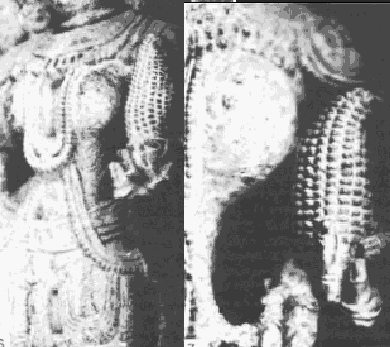
What is the Churning of the Ocean myth of the ancient Hindu doing on an early Mesoamerican carving?
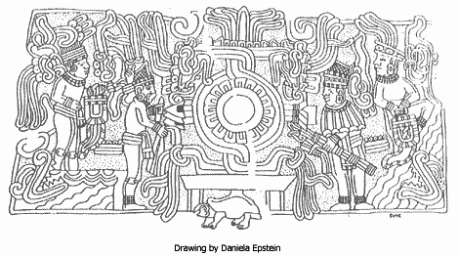
The Hopi will tell you that there was a bearded white-robed sage, they call, Massau, who gave them four stone tablets with carvings. The illustration below confirms that this travelling sage had an awareness of the Old World (Greek/Roman) mythology in his carving of the Fire Clan’s Hopi Tablet. The small print represents the Hopi understanding, the large print is what the Hopi call, ‘the breaking open of the tablet’ once the missing piece is discovered. That missing piece is the Dark Rift in the Milky Way, which rises with the sun on the December 21, 2012, Galactic Allignment.

With these tablets, discussed thoroughly in the Hopi Tablet Mystery, there is a corresponding petroglyph called Prophecy Rock in the Hopi territory.
.jpg)
Prophecy Rock was carved by Massau to illustrate the path of humanity through a coming crisis at the end of age. When certain prophecies were fulfilled, the Hopi were to reveal the sacred tablets and their meaning to the world. This opening of the seals of the Hopi tablets occurred in the late 20
th Century. A study of this ancient person, called Massau, and his trail across the Americas, helps to further understand the extent of this pre-Columbian contact.
There are similarities in the carving on Prophecy Rock with those of another ancient petroglyph from California shown here:
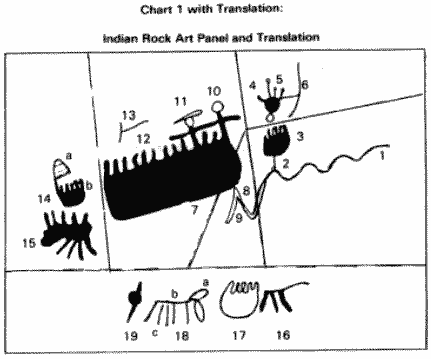 Translation
Translation:
In the beginning (6) the waters (1) Rose to the tops of the moutains (2, 8, 9). The Ark rode the waters (3) for some days and some nights (4,5). As the waters subsided (1,2,8,9), the Ark (7) came to rest (3) on a mountain (9) with Noah (10) and his wife (11) and all his family (12) at the end of the waters/folld (13,1). After the waters subsided and the land had dried up, Noah opened the window and removed the covering (the doorway) (14a) and freed (15) all the animals and the people (12,11,10). As each pair of animals (16) vacated the Ark (17) they (the animals, 18c) multiplied (18a) and populated (filled) the (lands of) the planet (Earth - 19).
Notice how it contains the same structure and angles of the Hopi’s Prophecy Rock. Research confirms that this petroglyph is a retelling of the story of the ancient flood, with a leaning toward early Hebrew origins[1].
Further study into the symbolism revealed a parallel between the Hopi Tablets and the Hindu writing of the Bhagavata[1] and that of the Hebrew Bible. The following symbolism on the Hopi tablets was found in these sacred texts:
- The path with footprints, thunderbolt and barley-corn in the
?r?mad Bh?gavatam 10. 16. 17-19; 10. 30. 24-26
- As above with sun, chariot and rolling in dust (as snake): SB 10. 38. 24-26.
- The (2) circling snake(s) with tongue defeated by the Spirit (Krishna): SB 10. 16. 25; Exodus 7: 9-12.
- The cloud and the spirit: SB 10. 16. 42-43; 7. 4. 22-26; Numbers 11: 24-25; Exodus 24: 15-16.
- The serpent defeated by feet: SB 10. 16. 54; Psalm 99.
- The four seas that purify souls: SB 9. 10. 34, 48.
- Lotus feet and boat: 10.1.5-7.
Also see Srimad Bhagavatam 6. 5. 1-13; Genesis 2: 10-14; 3: 14-15, 24; Daniel 14; 2 Samual 22: 1-20; and Psalm 72
Massau was not the only bearded white-robe of the ancient Americas. There was an ancient hero among the Mayan’s called Quetzalcoatl, who would return at this end of age. Quetzalcoatl’s return is predicted at the end of the Mayan Long Count, December 21, 2012. His name means the Plumed Serpent and also Precious Twin. He was a bearded white-robe and deified ancestor born of the virgin Coatlicue, the earth goddess. She assigned him to the task of bringing fertility to the earth and agriculture in the form of maize to humanity. As Lord of the Dawn, Quetzalcoatl struggled with Tezcatlipoca or Smoking Mirror, Lord of the Night, in the creation and destruction and rebirth of the Five Suns or worlds. Quetzalcoatl was likened to Ehecatl, the wind and movement god, movement which brings life and death and rebirth. Prophecies related that he would come from the east on a significant calendar date possibly on the raft of serpents he used to travel in the past. He introduced agriculture, writing and is patron of merchants, arts and crafts. His name was used for Mayan priests and rulers to emulate. He demanded the end of human sacrifices and limits on the sacrifice of animals, with occasional offerings of snakes or butterflies. His era, known as the Classic Maya period, saw a reduction of war, if compared to the Aztecs and Toltecs, most notably by the complete absence of Mayan fortified cities. His cities flourished in relative peace, advancing in the arts and expanding a Mayan civilization under common mercantile bonds[1]. Below he is depicted as a merchant bearing a sacred offering to carry through the Underworld[1]:
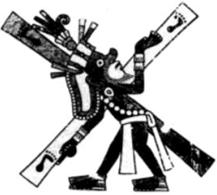
Quetzalcoatl is also called the Great Twin, who is accompanied on his journey through the Underworld by his twin Xolotl wearing a dog mask. Quetzalcoatl is the Morning Star, Lord of the East, Lord of the Dawn, life and rebirth and Xolotl is the Evening Star, Lord of the West, of the setting sun and of death. Together they travel the Underworld to retrieve the bones of the dead of the former world in order to recreate life in the new world. It is through these world life-cycles that the deities find the time and place to reach down and enter the world of the Maya.
When I was a child on September 5
th, 1975, a hysteria went about our schoolyard that this was the day that world would end. The hysteria drew up more of a playful energy among the children than out right fear. One of the religious groups of the day was seriously spreading the rumor. But September 5
th came and went, but the world remained.
More recently my own children spoke of the end of the world date of December 21, 2012. This prophecy stems from the Mayan long count calendar that has a 5125 year cycle ending on that day.
The end of the world day is called 13
baktun and will mark the transition of humanity from the Mayan’s fourth world to the fifth world. These four worlds of humanity are mentioned in the Vedic Laws of Manu, 71:
These twelve thousand (years) which thus have been just mentioned as the total of four (human) ages, are called one age of the gods.
Speaking of this end of the world date, a Mexican archeological site contains the early Mayan inscription called Tortuguero Monument 6, which reads[1]:
tzuhtzjo:m uy-u:xlaju:n pik
chan ajaw u:x uni:w
uhto:m il[?]
ye'ni/ye:n bolon yokte'
ta chak joyaj |
It will be completed the 13th b'ak'tun.
It is 4 Ajaw 3 K'ank'in
and it will happen a 'seeing'[?].
It is the display of B'olon-Yokte'
in a great "investiture". |
Ajaw, meaning ‘lord or priest’, is the 20
th day out of 20 on the Tzolkin Mayan calendar.
Kankin (uniw) is the 14
th (13
th) month of the Mayan calendar and means ‘yellow sun’.
Bolon Yokte, literally means ‘nine god’, who is deity of war and the underworld. He appears with a rope around his neck or an incense bag, which are Mayan symbols for an end of cycle sacrifice.
Based on the Mayan symbolism of these words the following translation is offered:
It is finished on 13
baktun
Lord Yellow Sun
Will appear
To display the 9 gods of the Underworld
In the plaza
Mayan cosmology relates the plaza with the Dark Rift of the Milky Way, where on 13
baktun or December 21, 2012, the Sun will rise at the opening of the Dark Rift. This marks the occurrence of what is known as the Galactic Alignment, which is the alignment of the winter solstice sun with the Galaxy’s center dividing the Milky Way into two equal parts in balance with the Earth’s equator[1].
The Quiche Maya call this the crossroads between
Xibalba be (the underworld pathway of the Milky Way) and the path of light and life (of the sun). The sacrifice of Quetzalcoatl (the feathered serpent) occurs at this crossroads. The result of this sacrifice is the rebirth of the solar deity to enlighten the earth toward a new purification. This rebirth occurs on Stela 11, where One Hunahpu, the lord of the sun, emerges from the mouth of the crocodile-frog with arms outstretched to represent the Mayan World Tree shown here[1]:
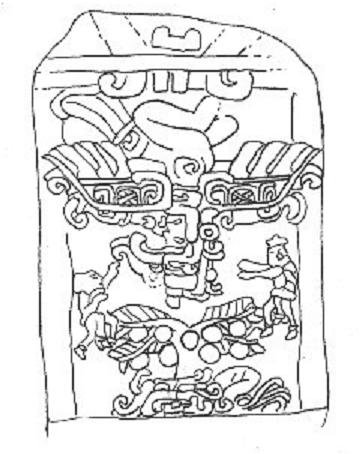
In 1519 the sign of the appearance of Quetzalcoatl (or his trickster twin Cortez) occurred on the exact calendar day and the event took two years to unfold, in this case, the Spanish conquest of the Aztec empire. Each new era begins at Quetzalcoatl’s patron city, Teotihuacan, where in pure darkness the upper realm was pressed against the earth with no sky to separate them. The hero twins begin to separate earth from sky in the opening of this Fifth World. The separation requires a decapitation of the jaw of the crocodile Cipactli. The body is used as the earth. This crocodile was a constant eater throughout the Aztec deluge, but now becomes a harmless abode for humanity to once again thrive upon. Cipactli is not only the deity representing the earth, but also the bringer of earthquakes[1].
Cipactli is shown here from the Borgonicus Codex with missing lower jaw and ears of corn growing from her back[1]:
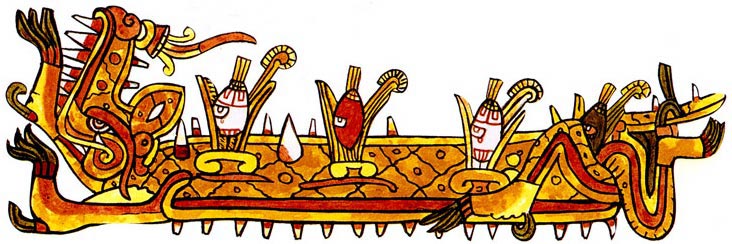
The Mesoamerican Cipactli is similar to the
Makara of ancient Indian mythology shown below[1]:
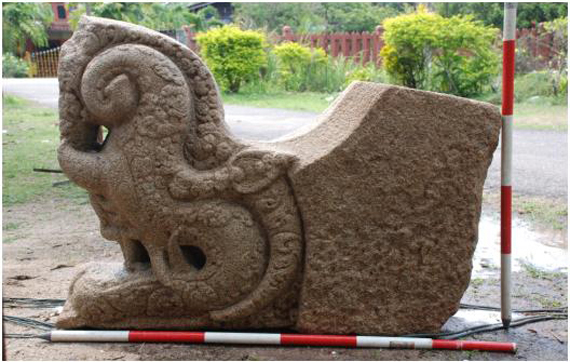
This Indian and Southeast Asian
makara in its aspect as
kirtimukha, the Face of Glory, is illustrated below with the great deluge and pearls coming out of his jawless mouth[1].
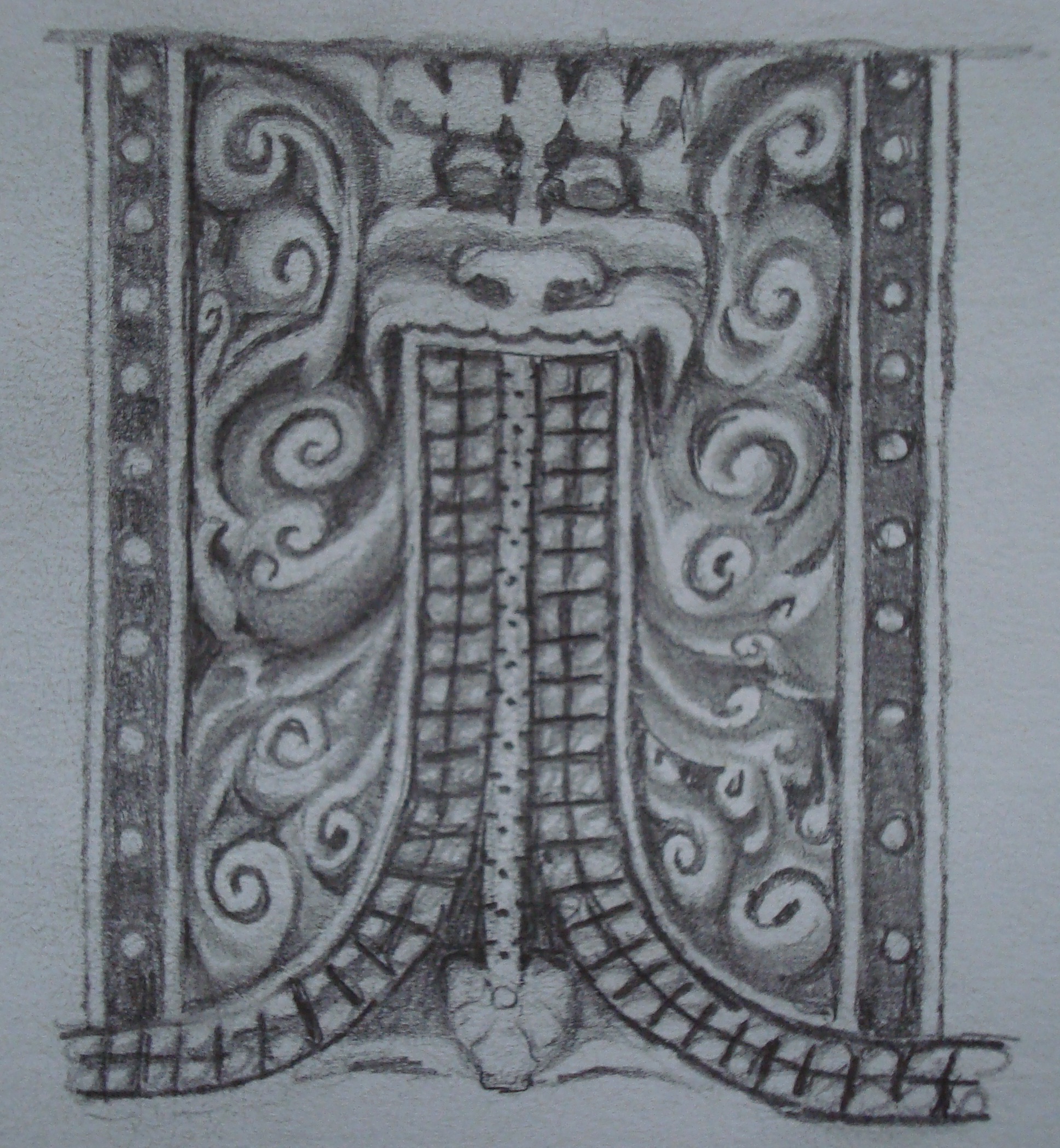
The Indian deluge myth relates that the waters of Ganges poured down on the head of Shiva, whose hair caused the waters to form rivers on the earth. Shiva enables the destructive potential of the waters falling upon the earth to become a source of life for all living things. The pearls represent the succession of the new generations and seeds, which will be born onto the new earth and live in harmony with it.
Makara or water monster and
mukha or face is related to
mugger, the Hindi word for crocodile.
The Mayan Chac, is deity of rain and crops. It is carved here at Uxmal without a lower jaw, remarkably similar to the Face of Glory in India. Chac holds a snake lightning-bolt, which combines fire with his water symbol to mean a sacred war. Chac may occur in four aspects as the old men of the four quarters of the earth, much like the Hopi, with each direction assigned his own color (east is red; north is white; south is yellow; west is black). He has been likened to the Feathered Serpent, Kukulcan (Quetzalcoatl)[1].
The Mayan Chac also has the long nose of the Hindu Makara. The illustrations of Chac below from Chichen Itza and Uxmal so much resemble the Indian elephant that there must have been a sharing of mythology in the ancient past[1].
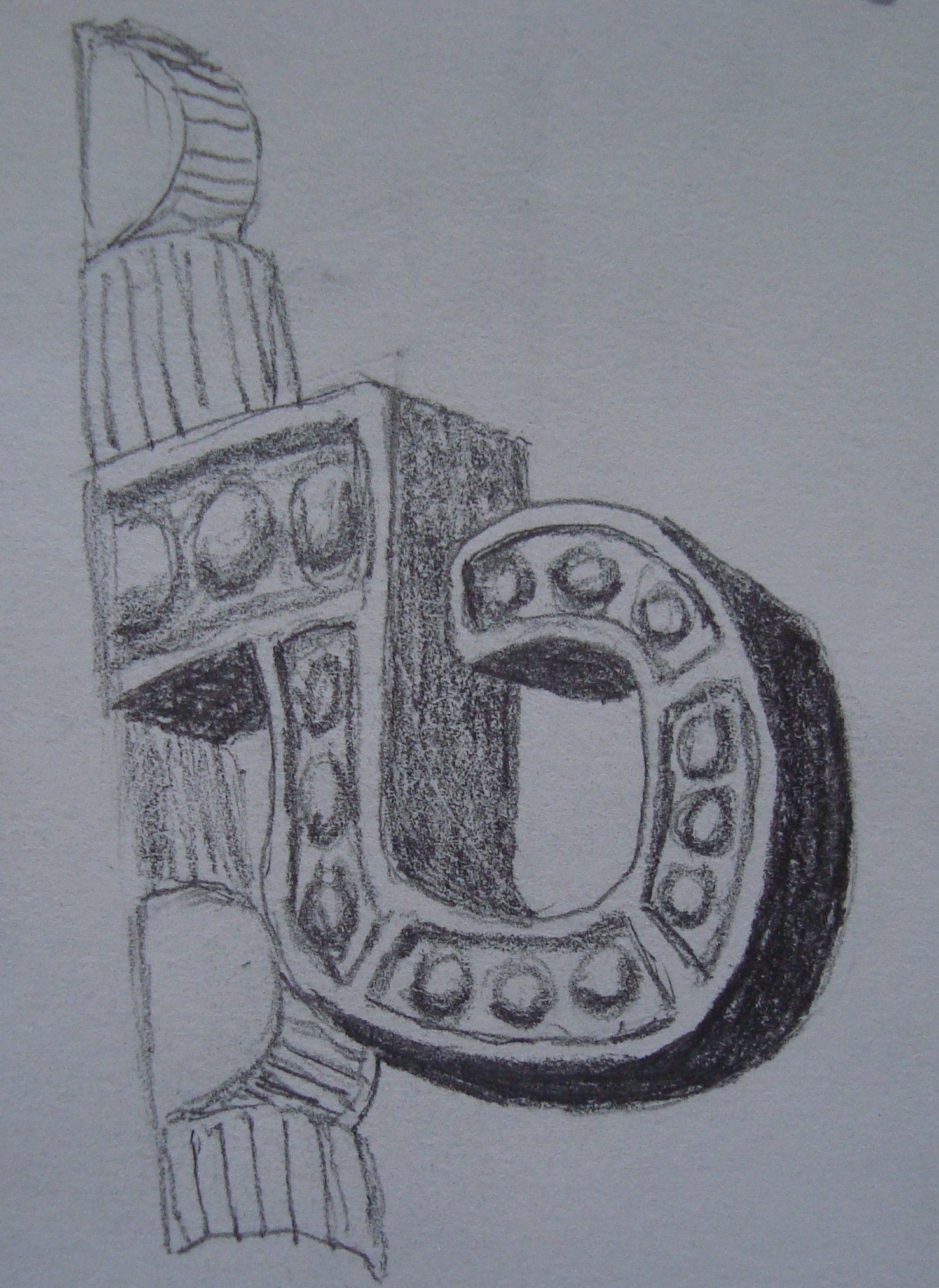
The Chac carvings of Mesoamerica appear to resemble the Indian elephant for the very purpose of leaving an ancient memory of contact between the sages across the continents. The stonework below from the ancient Mayan site of Labna contains the Chac ‘elephant-like trunk’ rearing back with the vision serpent jaws opening to reveal an ancestor.
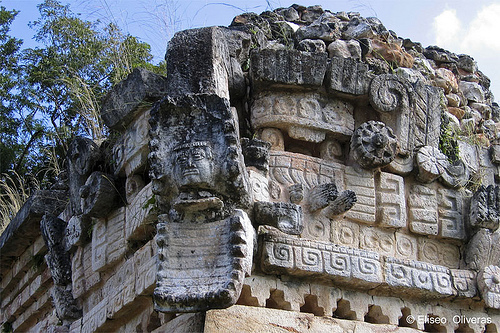
There is a purpose the elder sages of the past used combined a foreign elephant image with a local vision serpents. Modern research would deny any correlation. Yet, any child will tell that these are elephant tusks. First, consider the meaning of vision serpents in Mesoamerican art:[1]
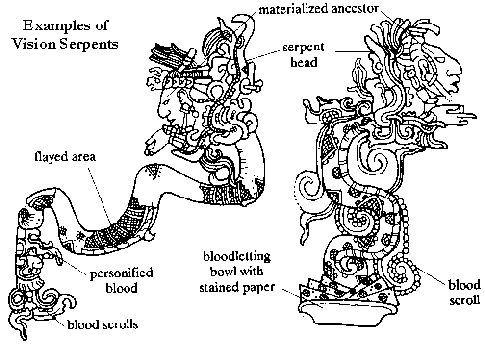
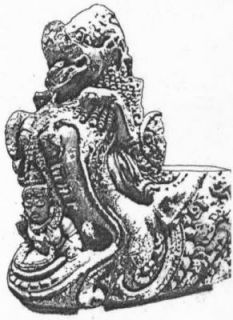
Quetzalcoatl as the bearer of the mask of Chac has an appearance and role similar to the vision serpent. In the Mayan bloodletting ritual, paper stained with the blood of the participant would be burned and the smoke would rise up with the hope of producing a vision. In the vision the smoke would form into a snake with two heads, one for the underworld and one for the earth. As a result an ancestor could travel through the snake from the land of the dead to the land of the living. The snake itself is considered a representation of the Milky Way, the abode of the ancestors[1].
The Plumed Serpent image makes perfect sense when the Milky Way is regarded as the snake. That is, as the night dissipates into dawn, the snake sheds its skin and the feathers of the quetzal appear as raise of the dawn.
There is further confirmation of pre-Columbian contact between India and Mesoamerica by the presence of American corn in Indian Temples[1]:
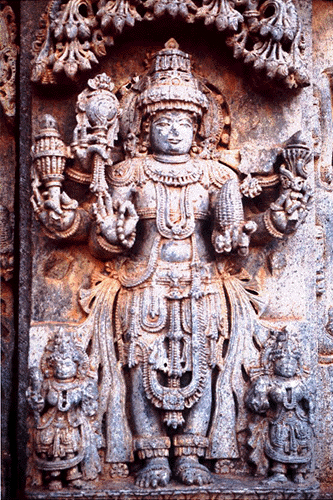
The corn is present in various 12
th Century ce temples in the Indian state of Karnataka. Such evidence solidifies the representation of Indian elephants on the stonework of ancient America. Further research into the sea trade and ocean travel capabilities and history of ancient Phoenicia will clarify the means of transport of these trade items and related cultural diffusion[1]. The ship of serpent from Quetzalcoatl’s journey may well have been a Phoenician vessel with serpent like oars as below[1]:
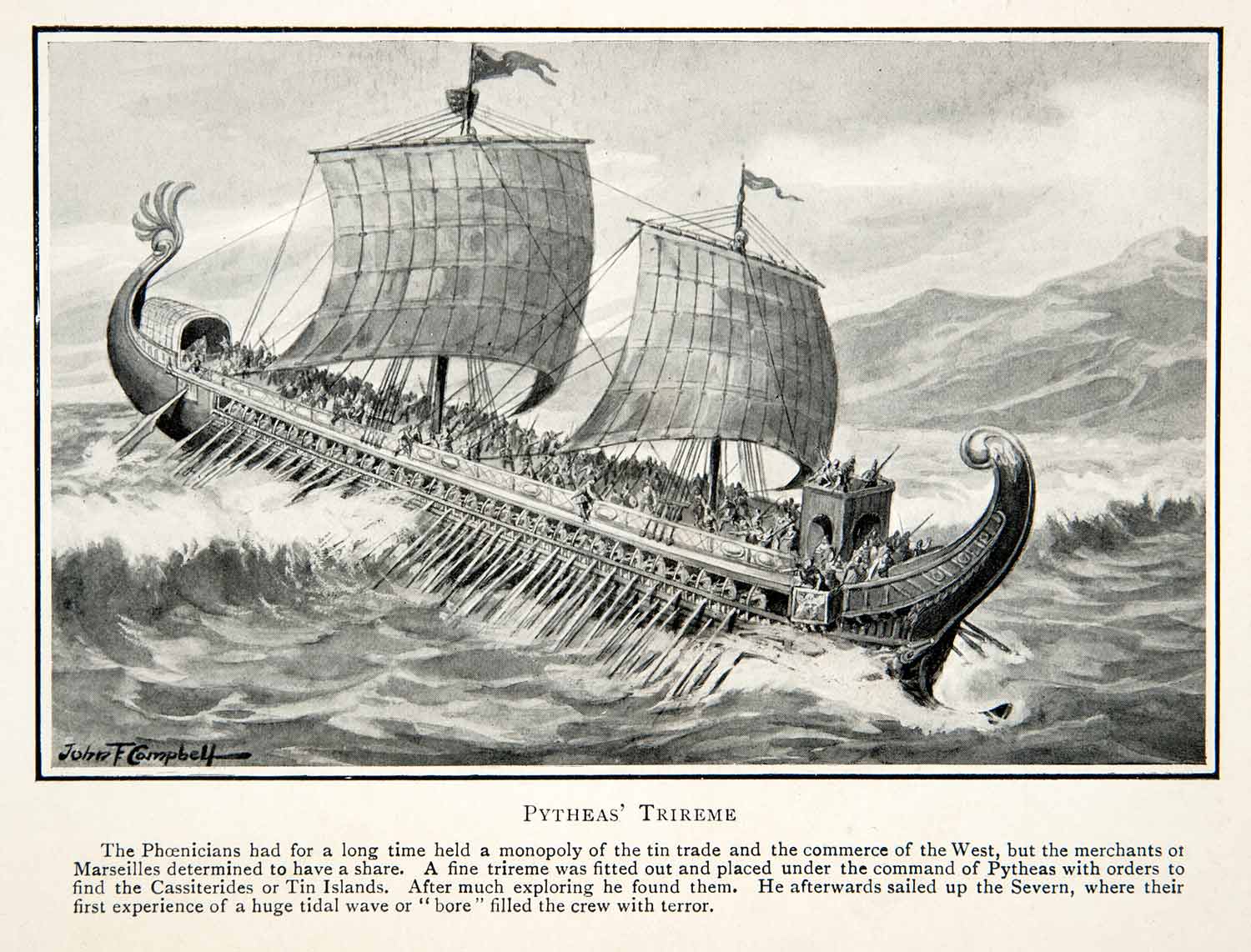
The Mayan word for serpent,
coatl, also means a pole. Quetzalcoatl travelled on a ship of poles. He was known as a traveller carrying a staff or even as a butterfly. When Cortez came to Mesoamerica, the sails of his ship were likened to butterfly wings and his appearance as a bearded foreigner with long robes caused the Mayans and Aztecs to believe he was the prophecy fulfilled of the return of Quetzalcoatl.
Supporting such transatlantic travel is the discovery of the Paraiba Stone found in Brazil which contains an ancient Phoenician inscription. The first line with translation reads as follows:
 The complete translation reads as follows in the words of a stranded Phoenician in South America in the 6th Century b.c.e.:
The complete translation reads as follows in the words of a stranded Phoenician in South America in the 6th Century b.c.e.:
We are children of Canaan from Sidon of the Eastern Kingdom of Merchants and are cast, I pray, here beside a central land of mountains (with this) offered choice gift to the Most High Gods and Goddesses in year 19 of King Hiram, I pray (still) strong, from the valley of Ezion-geber of the Red Sea. Thereby (we) journeyed with 10 ships and we were at sea together assuredly two years around the land of Ham. We were separated by the hand of Baal and no longer remained among our companions, I pray, we have come here, 12 men and 3 women at this new land. Devoted, I make, even whom men of wealth bow the knee, a pledge to the Most High Gods and Goddesses (with) sure hope.
http://www.scribd.com/doc/140852220/Phoenicians-in-the-Americas
For more ancient sources telling of a continent beyond the Pillars of Hercules go to:
http://www.theoi.com/Phylos/Atlantes.html. Look for instances where Phoenician storytellers may have attempted to hide their trading secrets with false information (For instance: the land is sunk and the sea impassable by mud; the island is only 2 days sailing off the Pillars of Hercules; the coast is covered with volcanoes and lava for hundreds of miles, etc.).
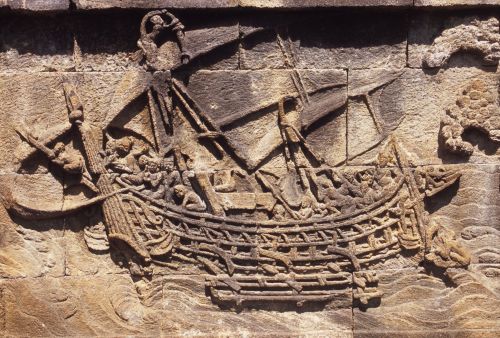 http://www.frontline.in/static/html/fl2625/stories/20091218262506200.htm
http://www.frontline.in/static/html/fl2625/stories/20091218262506200.htm
Ancient oceanic travel is frowned upon by modern scholars who guess that the ancients could only navigate along the coast, as they did not have the science or technology to travel the broader ocean. However, consider the above Borobudur stupa from Java, Indonesia of an Indian trading vessel carved in the 8
th or 9
th Century. Notice it contains an outrigger in order to stabilize the ship among the greater ocean swells.
In ancient India, the story of the Churning of the Ocean also produces a snow-white elephant, named Airavata, in which the deity of war, Indra, adopted as his own, to ride into battle accompanied by a dog. As the churning continued a grey-blue soup of poison rose to the surface. Shiva swallowed it to save the world from the poison and so his throat turned blue. Like Quetzecoatl-Chac of ancient Mexico, Shiva is the blue god of India, also taking on Rudra’s role as storm god.
Shiva has four heads to look in every direction for his beautiful wife. He also has a third eye that shoots flames. The snake of the Ganges is forever on his shoulder pouring down its water to give life to the earth, but also used as a weapon during floods and storms. Shiva carries a drum and a lightning trident, not unlike the lightning serpent of Chac.
One could compare Shiva to Quetzalcoatl in his role as the deity Chac and see the similarities involving the elements of fire, water, destruction and regeneration of life. Quetzalcoatl also compares with Indra in his journey to retrieve bones of the Underworld accompanied by the dog-masked Xolotl. This Underworld journey is depicted as a sacred war identified by the fire and water symbols of Quetzalcoatl. His jaguar and eagle warriors carry their bloodletting banners as a sign of their vision quest through the Underworld. After facing these pains with tears and blood, their warrior training is complete and they can be adorned with eagle feathers and jaguar skins. Like Quetzalcoatl, Shiva also had a snow-white face and was invoked by those performing penances (even with blood-letting in early India). What is most interesting is the vision serpent story associated with Shiva[1]:
In the Mahabharata, Arjuna, the warrior, invoked him (Shiva) by engaging in austerities until smoke issued from the earth. Then Shiva, ‘the illustrious Hara’, appeared in huge and stalwart form and wrestled with him. Arjuna’s limbs were bruised and he was deprived of his senses. When he recovered he hailed the god, saying: ‘Thou art Shiva in the form of Vishnu and Vishnu in the form of Shiva…. O Hari, O Rudra, I bow to thee. Thou hast a (red) eye on thy forehead…. Thou art the source of universal blessings, the cause of the cause of the Universe…. Thou art worshipped of all the worlds. I worship thee to obtain thy grace…. This combat in which I was engaged with thee (arose) from ignorance…. I seek thy protection. Pardon me all I have done.’ Shiva…embraced Arjuna and said, ‘I have pardoned thee.’
Shiva sometimes wares the skin of an elephant or a leopard. The Indian wild elephant is associated with Vivasvat, the deified sun, who as a shapeless child was rejected but was later carved into the sun to give life to the world. The chips that fell from his body became elephants. Brahma’s incantation helped release Indra’s elephant from a world-egg with other elephants, numbering 16 who went to the 4 directions to support the earth. The Indian Ouroboros (see below), akin to the Quetzalcoatl snake biting its tail, surrounds an elephant standing on a tortoise together supporting the earth. Much like the birth of Queztalcoatl in the Labna carving of Chac with elephant trunk and vision serpent (above), the white elephant of Buddhist China announces the Buddha’s birth. The Chinese deified elephant, Hsiang, carries the sacred jewels of the law, just as Quetzalcoatl the lower jawbone necklace of the world snake[1]. Like Quetzalcoatl’s conch shell necklace, the snakes lower jaw broken off is meant to herald an era of the law of peace.
Perhaps research into these similarities possibility can teach us something more of the prophecy of Quetzalcoatl about to unfold in history.
A few things cause modern research to lean away from exploring these memories of pre-Columbian contact. Modern researchers follow a type of learning based on individualism and the segmentation of the scientific method. No one person is to blame for chopping up our knowledge, it just happens that way. Yet, Indigenous World-view has been forever calling for an understanding of knowledge to be taken as an organic whole.
Humanity is often also unaware of modern biases against history. This bias tends to limit the accomplishments of early societies even going so far as giving credit for advanced technology of early Indigenous cultures to Aliens from outer space. As well, these gaps in historical knowledge are often left unexplored with the expectation that nothing will be found due to remote locations and distant times associated with those cultures. Exploring the harmony of these cultures akin to weaving a patchwork quilt will bring to light more of the history of who Quetzalcoatl was and what story he shared among Indigenous people.
The exploration of common bonds across Indigenous cultures can be directed toward ancient travelling sages, such as, Quetzalcoatl.
In the Yukatan, Quetzalcoatl, translated in Mayan as
Kukulcan, was also known among the Maya as their first priest, called Itzamna. In the
Historia Antigua de Yucatan, Itzamna was their instructor and:
gave names to all the rivers and divisions of land; … and taught them proper rights … was the patron of healers and diviners, and had disclosed to them the mysterious virtues of plants …. (he) first invented the characters of letters in which the Maya wrote their numerous books, and which they carved … on the stone …. He also devised the calendar…. Itzamna, regarded as ruler, priest and teacher, was, no doubt, spoken of as an historical personage [1].
Among the Mayan tribe of the Tzendal, they called him
Heart, in their language
Votan. Therefore, Votan may be akin to the
Popol Vuh’s mythical hero
Huracan, meaning ‘
Heart of Heaven’ from the Quiche Maya of the Guatemalan Highlands. Votan as a king of the 7
th Century c.e. was the founder of Palenque and travelled there past the ‘dwelling of the thirteen snakes’ from his ancestral home of Chivim. Votan and his men were called,
Tzequil, meaning petticoats, for their long robes. The 17
th Century Nunez de la Vega, Bishop of Chiapas, wrote of an account of Votan from a
Tzendal codex (with portions preserved in two secondary sources, the Bishop and Ordonez de Aguilar):
Four times Votan returned to his ancestral home, the land of Chivim. Returning from the first of these voyages he came upon a tower which had been planned to reach the heavens but was destroyed because of a ‘confusion of tongues’ among its builders. Prior to each voyage he divided the country into four districts…. Votan did not die, like ordinary mortals. When his time came he descended through a cave into the underworld and so found his way to ‘the root of heaven’.[1]
Quetzalcoatl, the Plumed Serpent, travel to the Underworld was likened to Votan’s dwelling in a cave. Providing a backdrop for the relationship of Votan to Quetzalcoatl, consider Quetzalcoatl’s prophecy. In this prophecy, Quetzalcoatl is due to return after 13 heavens and 9 hells. The celestial and underworld dwelling amount to time cycles of 52 years each. The end of the 13 heavenly cycles was believed to occur on the 1519 ce arrival of Cortez, the ‘twin trickster’ image of Quetzalcoatl. 13 heaven cycles by 52 years equals 676, back from the arrival of Cortez makes the beginning of the prophecy at 843 ce. 9 hell cycles times 52 years equals 468 years. Ushered by the arrival of Cortez in 1519 ce began the cycle of the 9 hells ending 468 years later on August 16, 1987. Therefore, Votan’s travel past the dwelling of the 13 snakes is related to the 13 heavens of Quetzalcoatl’s return prophecy. After all, snake relates to heaven in the quality to regenerate by shedding skin akin to an eternal life cycle.
Consider the following Izapa stela 67[1] depicting the rising sun maize god on December 21:
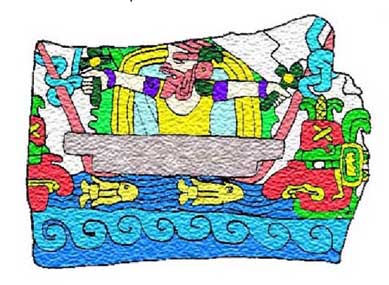
It parallels with Stela 11 of Part I above. A recap of Stela 11 identifies One Hunahpu, lord of the sun regenerating out from the sacrifice at the dark rift of the Milky Way at the constellation of Cygnus, on the December 21 winter solstice. The water below is coupled with the fire from the leaning smoking mirror sacrifice above the head of One Hunahpu. Being sacrificed on the leaning smoking mirror altar is the crouching jaguar. The heat of the sacrifice comes from the solar maize deity’s rays. This water and fire represent the sacred war much like on the 4 Movement Drum above. This warrior of the dawn is also standing in a ball-court and canoe as the victorious ball player. The winner of the ball game is sacrificed, and travels with the ball or the sun across the Milky Way, represented by the canoe, only to rise again at dawn on the other-side. Each Mayan ball-court had a hole in the centre representing the cave in the Milky-Way for the Maize deity to travel through toward the dawn. To hit the ball with the warrior’s hip into one of the two side rings represented the holes where the sun rises and sets[1]. The symbolism kept the game sacred enabling the player to strive for the goal of reaching the dawn of the Plumed-serpent, akin to achieving enlightenment and the soul’s own purification. On either side of Hun Hunahpu are his hero twin sons, Hunahpu and Xbalanque, who as ball players succeed through various sacrificial rituals to pass through and defeat the deities of Xibalba, the underworld. This scene is also depicted on this birth of the Maize god on the Uaxactum Plate.
Similarities between this plate from the Mayan lowlands of Guatemala and the following Hindu Churning of the Ocean carving in Southeast Asian’s Angkor Wat can be made[1]:
.jpg)
It would be a stretch to say the Hindu Churning of the Ocean is paralleled in Mesoamerican art if it were not for the following three pictures[1]: (from the Mayan Tro-Cortesianus Codex, the Veracruz Ball-Court stone carving and the Aztec Selden Codex respectively)
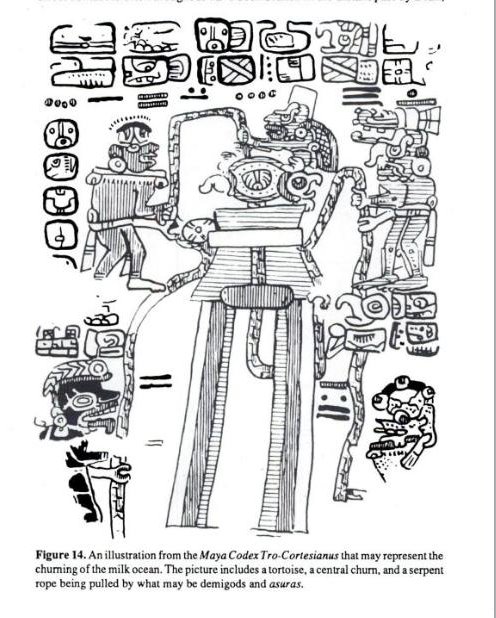
Visible in the codex image above are certain minor deities pulling the churning serpent much like in ancient India. There is also a churning machine below the turtle. (see above)
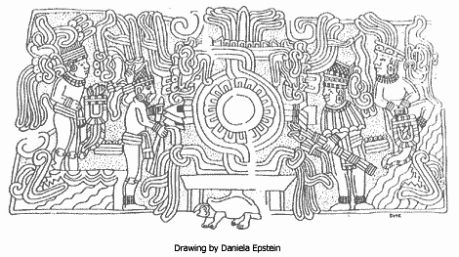
On the above ball-court stela, the turtle below the image of the ball-court canoe produces a solar image overlaying the arrows of sacrifice.
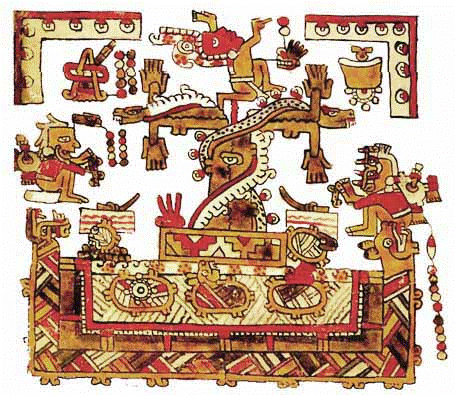
By Carl de Borhegyi copyright 2012
The world tree is used as the pillar of churning from Indian mythology on the above Aztec codex. The solar deity is born out of the centre of the world tree twisted by snakes.
One needs no sudden sign to appear on December 12, 2012, for a fulfillment of the long count prophecies. Just look at the Churning of the Ocean, with the grey poisonous soup rising out of the ocean[1]:
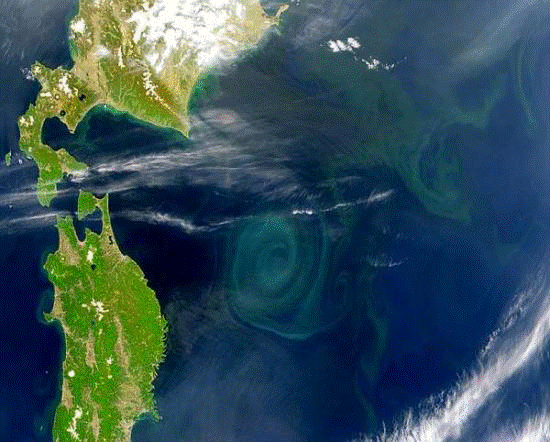
The World-Tree at the centre of the Churning of the Ocean represents the ancestral line of humanity in relation to all life on earth, together with our spiritual relationship with Mother Earth. The story of Hunahpu is one opportunity to listen to ancestral Indigenous sages and their advice regarding this great churning of human experience on earth.
The Mayan World Tree presents Hun-ahau firing a blow dart at the great Ancestral Bird - 7 Macah, with heiroglyphs that read:
Done by Hun-Ahau on 1-Ahau 3-Kankin he entered the sky, Itzam-Yeh[1]
From the above Popol Vuh creation scene the bird deity 7 Macaw (Vucub Caquix) rests on the world tree after the great deluge. According to the date listed this scene occurs 32 years before the end of the last Fifth-Sun Cycle (3148 bce). The hero twin Hunahpa uses his blow gun to bring down 7 Macaw. The solar bird deity loses its jaw as it falls to its death much like the crocodile above as this tree’s very root is the lower jaw of the crocodile. This falling of the Celestial Solar Bird occurs much like the Cygnus constellation in the Great Rift of the Milky Way. The Stela 2 of Izapa (as above) depicts the hero twins running to benefit from the sacrifice of 7 Macaw.
Essentially, the World Tree of Life that the hero twins run toward is now open for humanity to freely pick its life giving fruits. The sacrifice of the Solar bird happens before our world began, so that anyone in our world can receive the fruit of enlightenment. Below in this Olmec Stela the World Tree is the Milky Way crocodile with Hunahpu actually supporting the Celestial Bird recalling that they share the same sacrifice of death and rising at dusk and dawn[1].

The falling of Seven Macaw or Cygnus the Swan relates to the Hopi prophecy of the return of Massau and the emergence of the Fifth World[1].
It will come when the Saquasohuh (Blue Star) Kachina dances in the plaza and removes his mask. He represents a blue star, far off and yet invisible, which will make its appearance soon.
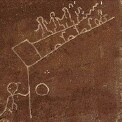 http://www.prophecykeepers.com/feedback.html
http://www.prophecykeepers.com/feedback.html
Notice how the Great Spirit of the Hopi petroglyph and Hunahpu of the Olmec stele each hold the World Tree supporting the sacrificial event of the world’s purification? There is also a correlation between this Prophecy Rock of the Hopi and the California Indian Rock petroglyph depicting the deluge mythology (see above).
The Blue Star of the Plaza in the night sky is the star, called Deneb, the blue star of the constellation Cygnus in the plaza of the Great Rift. This star is at the centre of the December 12
th, 2012 ‘dance’ of the Galactic Alignment between the Milky Way and the Sun which occurs every 26000 years.
The Blue Star, Deneb, The Mayan call this celestial crossroads the Great Tree or World-Tree, consisting of the Black Road (Xibalba) as the Milky Way and the Red Road as the Path of the Sun. The Sun represents the Creator and the Milky Way the ancestors. In terms of the Mesoamerican mythical significance, the Sacrifice of the Sun at this point causes the purification of the Milky Way and the earth. As discussed above, Quetzalcoatl is the offering made at the World-Tree to purify humanity. The Chichen-Itza Maya erected a central pillar in Can-Ek’s palace, called Yax-Cheel-Cab, ‘First Tree of the World’. At the western base of the World-Tree pillar was carved the mask, called Ah-Cocah-Mut. Mut means both bird and prophecy. It is the celestial bird of Seven Macah atop the Wacah Chan Tree of the Classic Maya. The mask represents death itself as illustrated in the growth of the maize corn plant on the Guatemalan bowl World-Turtle of the Maize God[1]:
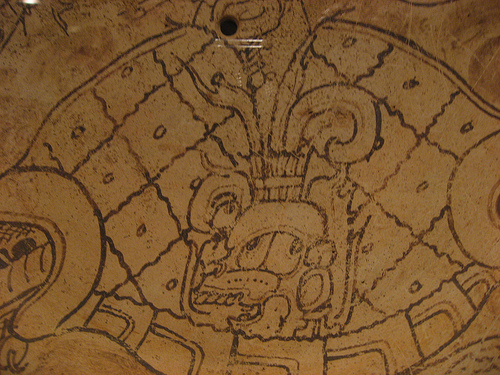
The Turtle-Twins emerge from the broken World-Turtle to water the dead seed represented by the skull mask in the lower centre of the turtle. Out of that seed the Maize God is born as their father who represents for the twins the living ancestral line. Beside the turtle above is a similar representation at Ek Baalam of the seed mask where the maize is sprouting.
The Hopi Blue Star Kachina taking off his mask and dancing in the plaza draws its meaning from the Mayan Maize God imagery. The Hopi were guided to live in their Fifth World after rising out of the Fourth World to the South. That covering of the fourth world occurred at Teotihuacan where early excavation required the removal of five feet of earth from entire plazas, streets and pyramids. The city was falling to invaders, so the inhabitants fled after burying their most sacred ruins. The Hopi were given their tablets by the Massau and the Elder White-Robed brother with instructions to recall the stonework from their former homeland[1]. The research leads to a journey with a community of maize growers who left Teotihuacan with their Lord Quetzalcoatl who gave them tablets and a prophetic message of his return on the end of their homelands Long Count Calendar.
The Sun rises on December 21, 2012 at the entrance of the Milky Way’s Dark Rift or Great Rift. This Dark Rift may be represented by a cave or the Crocodile Jaw from the above World-Tree representations. This is the final event on the Long Calendar and is carved on various altars and stonework of the ancient Maya. Consider the following Olmec altar[1]:
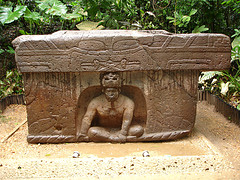
Out of a cave comes an eagle masked priest holding ropes that bind another person. Above the priest is carved the face of the jaguar where the mouth becomes the cave itself. In the mouth is the cross-roads glyph found above to also represent the Cygnus Constellation. Ropes are used in Mayan Codices to represent the stars joined together in constellations. The cave is the Dark Rift and the bound person is the Sun brought to that moment and place at the end of the Long Count Calendar. The eagle and the jaguar represent the sacred warriors participating in the event.
Another representation of the Dark Rift cave is given on Altar 5 at La Venta of the Olmecs[1]:
.jpg)
In the arms of the priest whose mask of budding corn is coming off, lies Were-Jaguar Child. The Jaguar who lived in caves is represented in Teotihuacan as a netted jaguar or with a twisted rope between its eyes. The Maya often depict him as the fierce deity of the Underworld Sun and of human sacrifice. The netted jaguar represents the noosed Sun at the conjunction of Cygnus (twisted rope) and other sky events at the end of the Long Count Calendar. The Child-Jaguar on this altar stone has been misrepresented as a child sacrifice. Around the edges of the altar a growing infant jaguar is also represented. The imagery tells of the birth of the Underworld Lord of the Sun as a human being.
Quetzalcoatl’s name as Plumed Serpent occurs also among the North West-Coast Salish, as Quaaqua, and the Tlingit, as Yetl. The Zuni language named him, Kaloowise and the Hopi called him, Palulukon (Wuwuchim). Based on the description of Quetzalcoatl as a travelling
white-robed healer and sage, various derivatives of Ehecatl, Lord of the Wind, and Huitzilopochtli, Lord of the House of Dawn, are also attributed to Quetzalcoatl[1]. The Puan of the Georgia region called him, Eseecowah, also meaning Wind and Water Lord. Those as far north as the Algonquin called him, Chee-zoos, God of the Dawn Light[1].
The following stone from Los Lunas, New Mexico, contains carvings of the Ten Commandments in ancient Phoenician /Hebrew Script. Given the information of early American contact with a bearded white-robed sage (likely of Hebrew origin), a study of such artifacts can no longer be merely dismissed by scholars who lean so heavily on their bias that they break an honest scientific study of such finds.
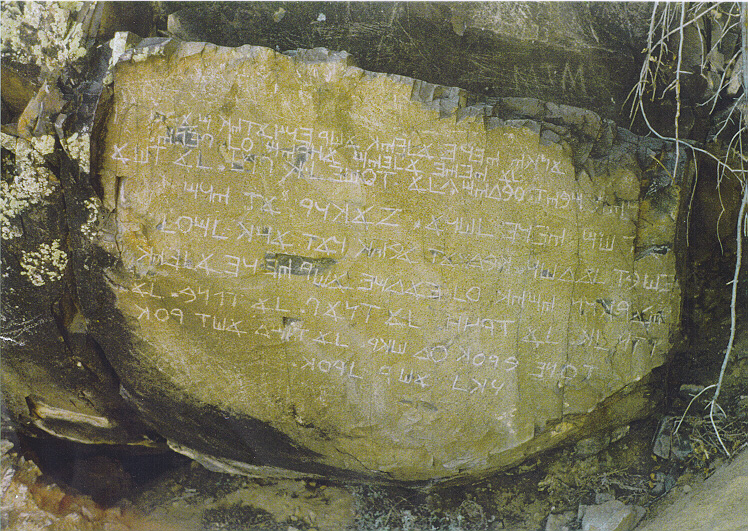
http://www.revelationsofthebible.com/LosLunas.htm
The Kalispel and Flatheads of the Montana region expected the return of their bearded white-robed sage whom they called, Shining Shirt. Their ancient myths and stories of Shining Shirt were complemented by a vision of a dying 12 year-old Kalispel girl in the late 1800s[1]. She saw a woman who called herself Mary with a child enter the door of her teepee. Is this the Were-Jaguar Baby the Olmec carved on their altars? The decision of the majority of Mayans to follow the message of Our Lady of Guadeloupe points to the answer. More study in this regard is provided by Wikipedia[1].
All these symbols considered offer a continuity of beliefs in the after-life, which bound Mesoamerican eras, peoples and cultures together. Much of this spiritual bond can be credited to Quetzalcoatl and his ever-present influence throughout the region. Consider this Nahuatl song from one of his major cities:
And they called it Teotihucan
Because it was the place where the lords were buried
Thus they said, ‘When we die, truly we die not,
Because we will live, we will rise,
We will continue living, we will awaken: This will make us happy.’
Thus the dead one was directed when he died:
‘Awaken, already the sky is rosy, already the dawn has come,
Already sing the flame colored guans, the fire colored swallows,
Already the Butterflies fly.’
Thus the old ones said that who has died has become a god,
They said: ‘He had been made a god there,’ meaning, ‘He has died.”
The Hopi mythology also corresponds with this sacred city of Teotihuacan. To the Mayan, Teotihuacan was covered with no sky at the beginning of the Fifth World. To the Hopi, the Fifth World consists of a digging out of the ground of the Forth World and rising up on the web of Grandmother Spider to the Fifth as described above with a literal burying of Teotihuacan in five feet of earth[1]. This protective covering over Teotihuacan, the Sacred City of the Fifth World, provides a powerful image of the mission of Quetzalcoatl, the Plumed Serpent, on December 21, 2012, the birth of the Fifth World of the Hopi. Those who are born through this event, by imitating the sacrifices and shedding of old skin of Quetzalcoatl, will be protected by the covering of Mother Earth.
The research digs up a surprise when following the clues of the interpretation of the Hopi tablets given in the Introduction above and the correlation between the Hopi Massau and the Mayan Quetzalcoatl. To the Hopi, the true Pahana will bring with him a new dawn of the Fifth World, he will teach them the meaning of all these signs, plant the seeds of wisdom in their hearts and smooth the way to the emergence of the Fifth World.
The Dancing Kachina represents a blue star, far off and yet invisible, which will make its appearance soon. The far off blue star, Deneb, will be invisible by the light of the Sun on the morning of December 21, 2012. But its symbolism represents the sign we are given that unites all people under the vision of the Creator to live in harmony with the earth. To the Hopi, the time is foretold by a song sung during the Wuwuchim ceremony. Together we dance with the Blue Stone High Priest who sets the example. To the Hopi his name is Kachina; to the Maya it is Quetzalcoatl; to the Hebrews it is the High Priest with the Sapphire (Blue) Stone; to the East Indian it is the blue throated Shiva who swallows the poison of the ocean of human corruption. That is what makes the Emergence to the next, Fifth World.
The Hopi and others who were saved from the Great Flood made a sacred covenant with the Great Spirit never to turn away from him. He made a set of sacred stone tablets, called Tiponi (see Introduction above), into which he breathed his teachings, prophecies, and warnings. Before the Great Spirit hid himself again, he placed before the leaders of the four different directional or culture groups four different colors and sizes of corn; each was to choose which would be their food in this world. The Hopi waited until last and picked the smallest ear of corn. It was the sacred color blue. This, the Great Spirit said[1]:
It is well done. You have obtained the real corn, for all the others are imitations in which are hidden seeds of different plants. You have shown me your intelligence; for this reason I will place in your hands these sacred stone tablets, Tiponi, symbol of power and authority over all land and life to guard, protect, and hold in trust for me until I shall return to you in a later day, for I am the First and I am the Last.
As a result of this research pointing to Hebrew Messianic imagery, a study of the measurements of the unearthed city of Teotihuacan of ancient Mexico was made using Hebrew and Greek Gematria with original Mayan Hunab measurements. The following initial results illustrate various legible Hebrew words related to the Kabbalah world tree produced by the street and building measurements of Teotihuacan and will reveal the land of origin of Quetzalcoatl in a verifiable manner.
The city of Teotihuacan consists of the Avenue of the Dead running north from the Pyramid of the Moon to the south past the pyramid of the Sun on the left (eastward) all the way to the Temple of Quetzalcoatl, also on the left. This avenue used to be a river cascading down steps all along its path. The steps were designed with specific dimensions with each of the ten sections having their own unique length and width measurements. In his efforts to measure these sections and the three temple pyramids, Hugh Harleston found the Mesoamerican measuring unit, he coined the Hunab. The following diagram contains some of these Hunab measures:
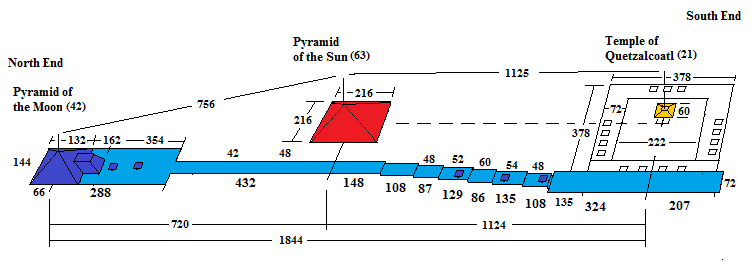
Also labeled above are the dimensions of the Pyramid of the Moon, the Sun Pyramid and the Temple of Quetzalcoatl. Some measurements that Harleston found repeated throughout the complex are also listed.
Harleston believed that one of the reasons for a city with these specific designs was to illustrate various celestial distances, such as, the distance between planets. It is a possibility, since the primary temples are built for the Sun, Moon and Venus (Quetzalcoatl, as Morning Star). This research has added another possibility. What if the numbers themselves represent symbols or concepts that point toward a mythological story?
In Part II of the End Time Prophecy, the research considered that Quetzalcoatl may have been a foreigner from across the eastern sea and that he may have traveled with ancient Mediterranean sea traders. If so, (and this was just a hunch) influence on the design of this city may have come from anywhere in the world, even from the ancient indigenous tribes of Israel. Though this is a stretch in the research, an investigation into the use of Gematria or word-number associations from Hebrew Kabbalah has been made.
These initial surprising results (found on December 20, 2012) are listed below:

Aur is also the birthplace of Abraham. Aur or Ur as a location meant the City of the Light or City of Enlightenment. It was there Abraham was given understanding of his call from God to leave his own security and land to seek out and find the Promise Land.

The use of two possible Hebrew words found from Gematria (number correlation) is logical so long as the words expound each other and not merely make up different meanings. For instance, The Ein Sof tree begins with three roots. The first is Ein, meaning Nothing. The second root is Ein Sof, meaning Without End. The third root of the Ein Sof tree is
Aur Ein Sof, meaing Endless Light. Therefore, the 207 of Aur complements or expounds upon the 207 of Ein Sof. Similarly, Chesed as the second principal or Sefirot of the Ein Sof World-Tree is represented by 72, which corresponds with 207 due to the location of the measurements and the meaning of the word associations. That is, 207 is a length of the flooded avenue exactly where 72 is the width. And Chesed is the primary virtue or fruit applied to the Ein Sof tree. As well, when 72 produces
Ab, meaning cloud, the Hebrew Scripture associated with cloud in 1 Kings 18:44, the cloud rises out of the sea like man’s hand and relates directly to the numbering of the Right Arm of the Heavenly Man. The cloud produced the rains forecast by the prophet Elijah who overcame the 450 prophets of Baal on Mount Carmel. Interestingly, 450 minus 72 equals 378, the Length of the complex of the Temple of Quetzalcoatl which runs along the length of the 72 Hunab wide river of the Avenue of the Dead.
The measurements of this city consistently defines Hebrew Qabalah and the Ein Sof Tree of Life. Consider the numbers 48 x 324, measured immediately beside (north) those listed above.

To clarify, the four measurements above (207, 72, 24 and 324) can be found on the above diagram in the southern section of the Avenue of the dead, where the river used to run. It consists of the section of the river beside (or west of) the Temple of Quetzalcoatl.
Look at the foundational measurements of the Temple of the Sun (216x216) and the Temple of the Moon (162x132) listed below:
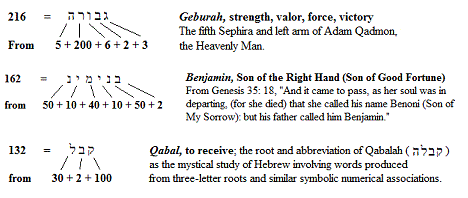
The teachings of these Hebrew sages coincide with the mythology of Teotihuacan. That is, where the Temple of Quetzalcoatl is associated with his divine sacrifice, the Qabalah virtue of Loving Kindness (Chesed) can be measures. Where the Temple of the Sun is located to celebrate the rising again of the divine being, the Qabalah virtue of strength or victory (Geburah) can be measured. In the identification of the width of the Temple of the Moon (132) as being associated with Qabalah itself, obvious designs are beginning to unfold. From the onset, the numbers match with practical teachings of Hebrew Qabalah. Either Hugh Harleston made his measurements up to match Hebrew Qabalah, or someone else did 2000 years ago in participating in the design of this Mesoamerican city of Teotihuacan.
Notice also the length and width of the Temple of Quetzalcoatl (378x378) added together as 756 produces the word Sephiroth itself:

On December 21, 2012, I humbly offer you this sign of the times. My children, my wife and I are eager to celebrate Christmas and New Years together as always. Right now, I am honored to share this one day in 26000 years as a particular Jubilee festival to end our 4
th World with repentance and forgiveness and to enter the New Fifth World with hope, jubilation, courage, harmony and restoration.
Much work must be done to share nearly a decade of research that led to this remarkable find. Part of that work will be to remove the Mask of the Elder Brother, the Kachina with the Saphire (Sephiroth) Blue Stone, whom the Hopi prophets foretold. He is the one spoken of by every culture and religion that has ever read the stars, interpreted dreams or watched their prophets dancing in the plaza and shouting from the mountain top the way to become new individually and as a world community.
There are dozens of measurements that match up in this way to share in the future. Perhaps others will verify this work finding and using the Gematria of Teotihuacan in their own research. This seems almost miraculous all these Mayan numbers matching Hebrew philosophy. Perhaps it is. But there is a definite human intellect at work in the design, since a mere human was able to rediscover the work. A study of who those humans were is in order for perhaps a Part IV of this research. How did they interact with other sages from other Indigenous tribes like their own from all over the world? Perhaps the greatest miracle of all is the fact that the mark these sages left at Teotihuacan was agreed upon by the Mayan people who went about the task of building this city without walls by their own free will. Therefore, a study of a world community of sages toward common values, common experiences, a common humanity toward a common good is in order. Research into this study can benefit from an understanding of comparative mythology world-wide and Indigenous world-view from those cultures not overrun by insatiable materialist economies.
Happy Jubilee December 21, 2012. May the Heavenly Person continue to grow in your life as you share in the fruit of the World-Tree of Life toward divine, human and ecological harmony.
This research is verifiable using Hebrew Gematria[1], but does not necessarily reflect a complete analysis. What is interesting, however, is that the original Pyramid of the Sun was covered on the top platform with a layer of Mica. It would have appeared to shine with the light of the rising Sun if viewing it from the Pyramid of the Moon. That distance between the top of each pyramid calculated out the Hebrew equivalent of Mica, which is Electrum. It occurs in the Hebrew book of Ezekiel and reads as follows[1]:
Now it came to pass in the thirtieth year, in the fourth month, in the fifth day of the month, as I was among the captives by the river Chebar that the heavens were opened, and I saw visions of God….
And I looked, and, behold, a stormy wind came out of the north, a great cloud, with a fire flashing up, so that a brightness was round about it; and out of the midst thereof as the colour of electrum, out of the midst of the fire….
And above the firmament that was over their heads was the likeness of a throne, as the appearance of a sapphire stone; and upon the likeness of the throne was a likeness as the appearance of a man upon it above….
And I saw as the colour of electrum, as the appearance of fire round about enclosing it, from the appearance of his loins and upward; and from the appearance of his loins and downward I saw as it were the appearance of fire, and there was brightness round about him.
On December 21, 2012, Quetzalcoatl is going to dance in the Plaza of the Pyramid of the Moon, hidden as a blue star, Deneb. He will silently call all those who know him. The world will continue on its path valuing those things that it has valued that will all be taken away. But the Fifth World will be covered and born again out from the dead skin of a snake. They will spread their wings as eagles and fly up to join the Sun.
References:
http://www.skyscript.co.uk/cap_myth.html
http://history-world.org/phoenicians.htm
http://oceanmotion.org/html/background/timeline.htm
For further research see Vase of the Seven Gods, Cave of the Seven, the Seven Cities of Gold, the Six Cities of Refuge (plus Jerusalem) and the Seven Sunken Temples: http://mythicmysteriesmiscellany.devhub.com/blog/498921-maya-vase-of-the-seven-gods/
http://www.ahastories.com/hopiprophecy.html
http://www.iawwai.com/NorthAmericanProphecies.html
http://sun-nation.org/sun-hopi-people-of-peace.html
http://www.viewzone.com/thomasomills.html
http://theslideprojector.com/art9/art9lecturepresentations/art9lecture12.html
http://popular-archaeology.com/issue/june-2011/article/ancient-peru-the-first-cities
http://en.wikipedia.org/wiki/Quirigu%C3%A1
http://en.wikipedia.org/wiki/File:Dalailama1_20121014_4639.jpg
http://arunshanbhag.com/tag/kailash-manasarovar/
http://www.joannamacy.net/thegreatturning.html
http://holeinthedonut.com/2012/03/12/peru-ancient-cultures-moche-chimu/
http://www.thedreammasters.org/hopi/martingashweseoma.php
http://www.garlandsrugs.com/collections/collectibles-home/products/hopi-rattle
http://www.boereenheid.co.za/viewtopic.php?f=64&t=63
http://www.creationism.org/csshs/v07n4p06.htm
Clendinnen, I. (1991). Aztecs – An Interpretation. Cambridge University Press. Pp. 101-104.
http://www.flickr.com/photos/tribalinknews/page8/
http://belsebuub.com/articles/the-spiritual-meaning-of-the-spring-equinox
http://www.crystalinks.com/aztecgods2.html
http://www.halexandria.org/dward417.htm
http://www.azteccalendar.com/day/Xochitl.html
http://www.azteccalendar.com/day/Ollin.html
http://www.azteccalendar.com/?day=21&month=12&year=2012
http://tlacatecco.com/tag/aztec-calendar/
http://www.mexicolore.co.uk/index.php?one=azt&two=ask&tab=ans&id=13
http://library.thinkquest.org/08aug/01219/Chnsmyth.html
Illustration by the Author; http://en.wikipedia.org/wiki/Makara_(Hindu_mythology); http://kirtimukha.com/devilsMask.htm
Illustrated by Author, the deity Chac of Uxmal and Chichen Itza temple.
http://www.jacksbromeliads.com/mayancivilizationii.htm
Illustrated by Author, the deity Chac of Uxmal and Chichen Itza temple.
http://www.unexplained-mysteries.com/forum/index.php?showtopic=48040&st=45
Laughton, T. (2004). The Maya – Life, Myth, and Art. New York: Barnes & Noble Books. P. 115.
The Dhammapada. Translated by V. J. Roebuck (2010). New York: Penguin Books. Pp. 174-175.
http://www.harekrsna.com/sun/features/04-12/fe



.jpg)














.jpg)








.jpg)





